Stone Curves Co-Housing Community
A passive rainwater-harvesting retrofit
This 48-home co-housing development, built in 2004, is a good example of how a site with no water harvesting in its approved and permitted plans, can be retrofitted to incorporate passive water harvesting earthworks throughout its landscape without having to submit new plans or revisions.
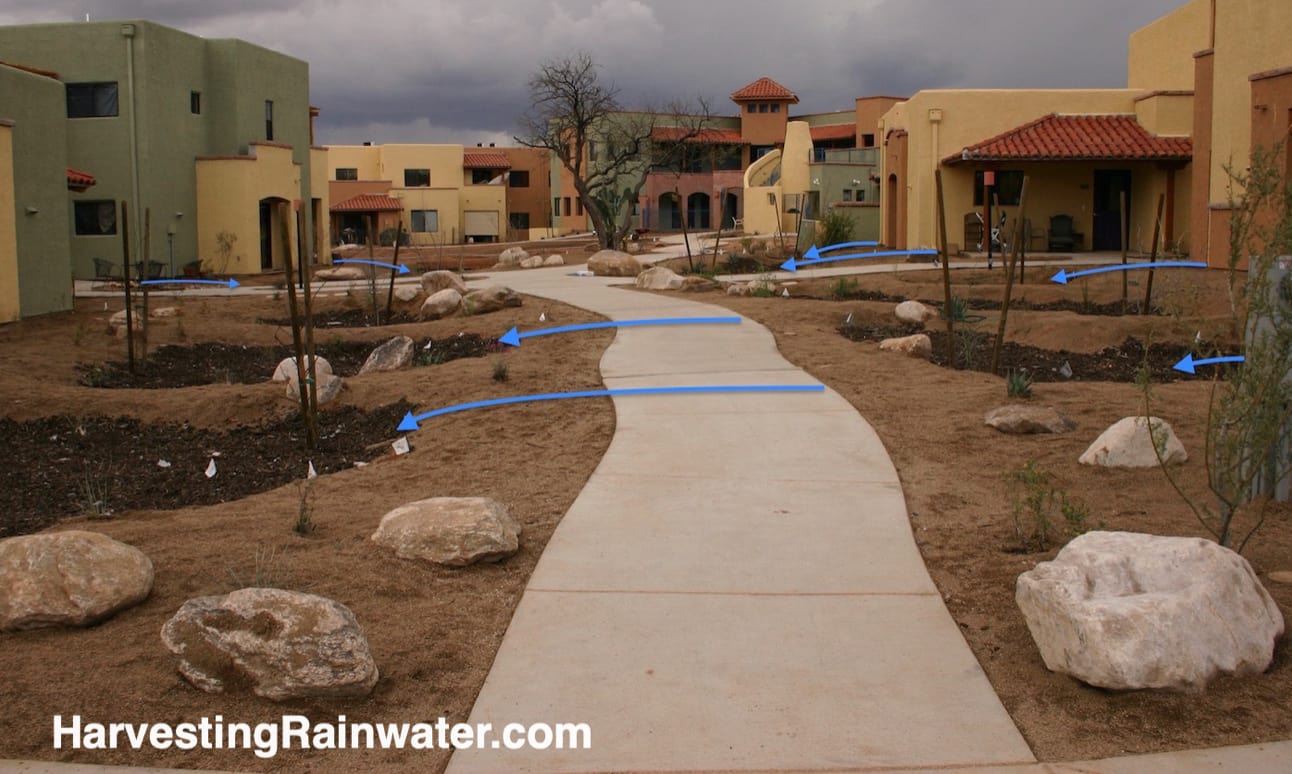
Blue arrows denote water flow.
Photo: Brad Lancaster
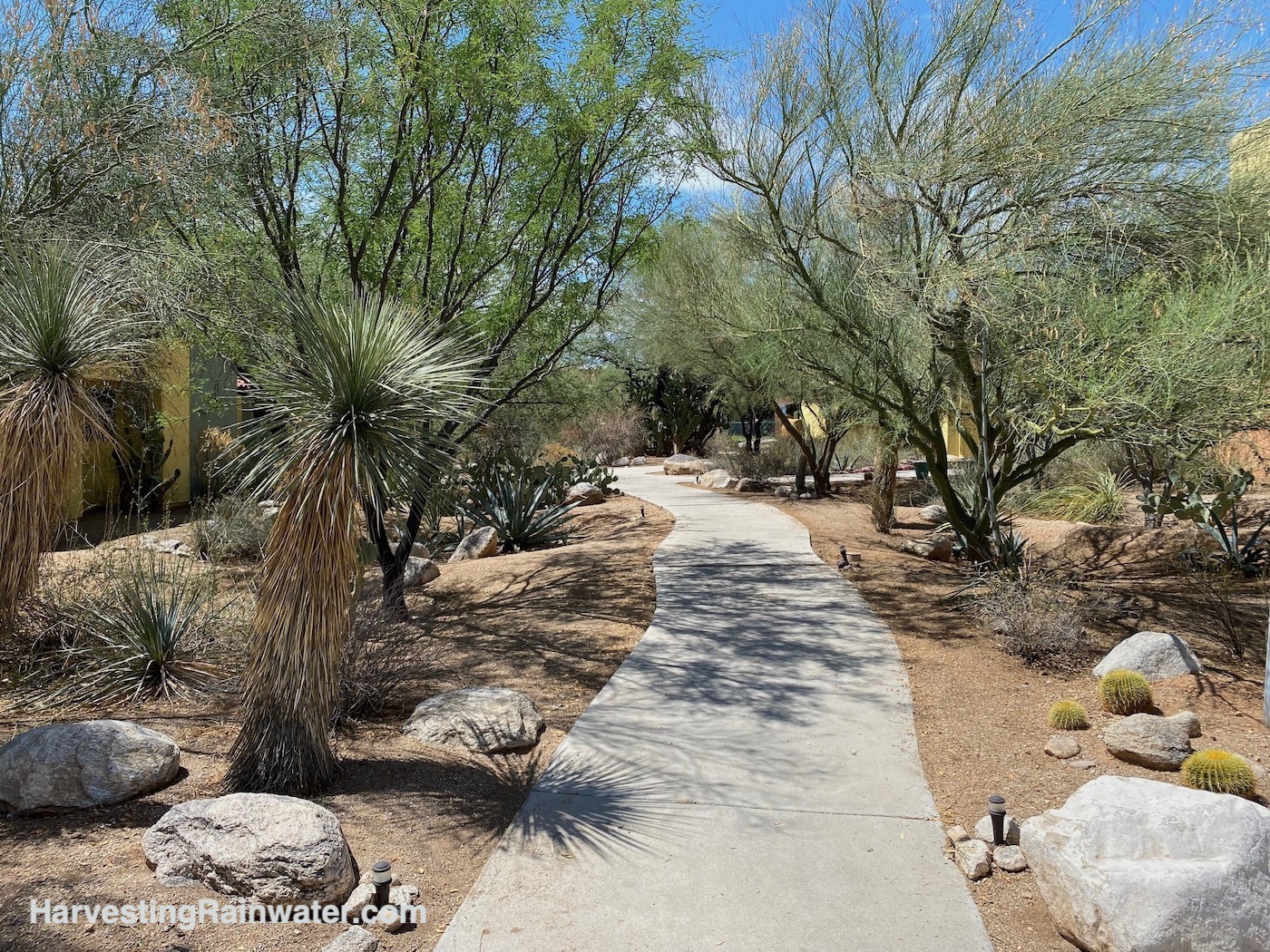
Photo: Brad Lancaster
Unlike the Milagro co-housing development—where the water harvesting was integrated into the site plans from the beginning, at Stone Curves the water harvesting was created after the plans were approved and permitted by the City of Tucson, but before any vegetation was planted. So, while some of the water-harvesting basins are not ideally sized, it’s great that they exist at all.
The approved plans had no water harvesting, only large single-use, flood-control retention/detention basins at the bottoms of the site, leaving the rest of the site drained and dehydrated.
Once the buildings were constructed, and before anything was planted, the water-harvesting retrofit began.
Water-harvesting basins were created everywhere within the common landscape (front yards, along public paths, within courtyards, and around parking lots) where there were to be plantings, so the rain was planted before the plants. This was done from the highest points of the site’s landscape all the way to the bottoms, so the entire landscape would retain, rather than drain the rain. This dramatically enhanced the flood control performance of the site, so almost no stormwater water now drains off the landscaped areas harvesting their water.

Photo: Brad Lancaster

Photo: Brad Lancaster

Photo: Brad Lancaster, 5-2008.
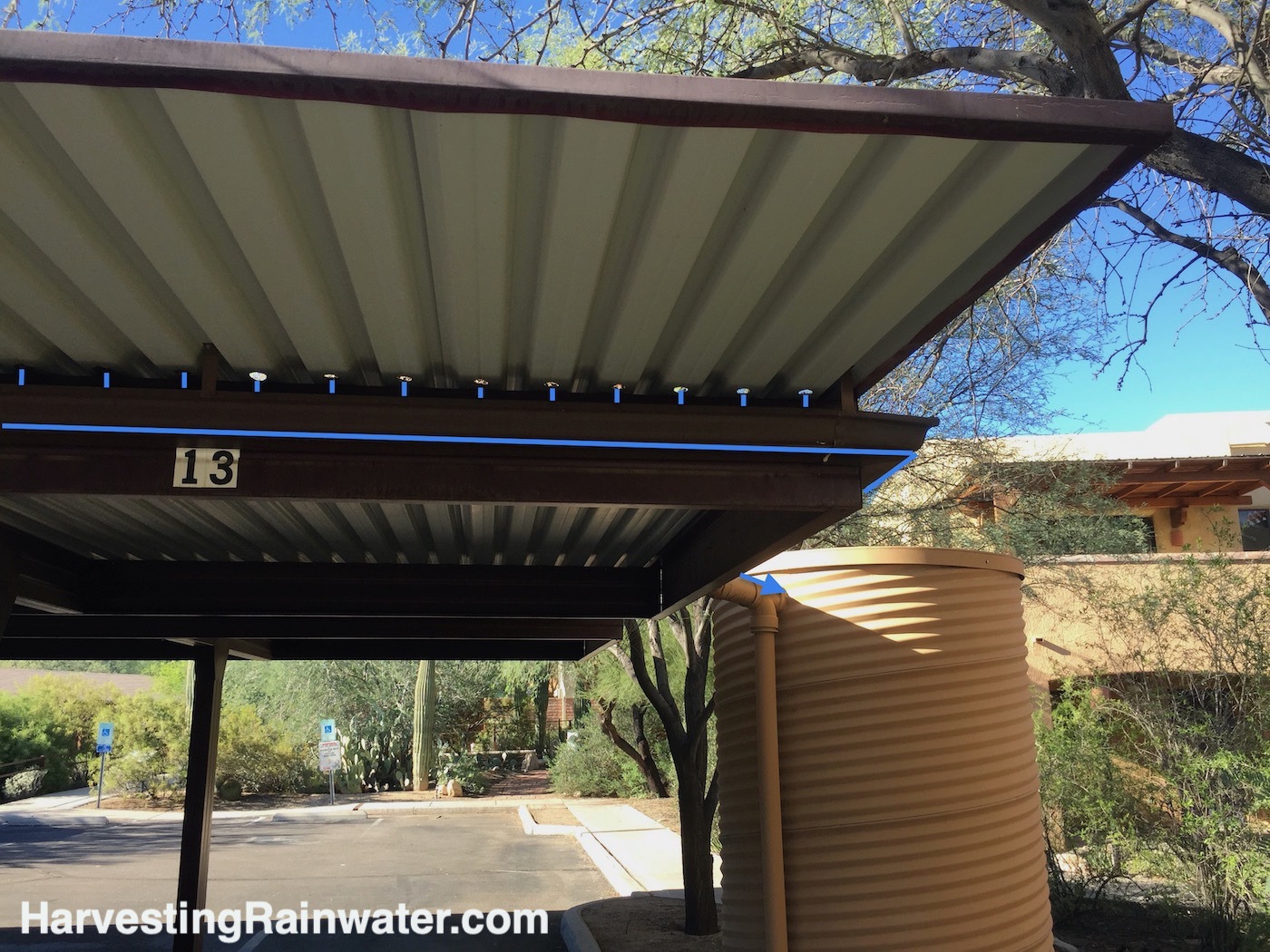
To save money, this could be done without any tanks, by just directing carport roof runoff direct to the landscape and its water-harvesting basins.
As with any roof and gutter system, it is wise to sweep clean all before every rainy season to ensure an unblocked water flow.
Photo: Brad Lancaster

To save money, this could be done without any tanks, by just directing carport roof runoff direct to the landscape and its water-harvesting basins. Work by Technicians for Sustainability.
As with any roof and gutter system, it is a good practice to sweep clean all before each rainy season.
Photo: Brad Lancaster, 10-2008.
The single-use flood control detention/retention basins at the bottoms of the site (which would no longer get flooded due to the amount of water harvesting upslope of them) were then repurposed to serve multiple uses, becoming community gardens, dog and chicken runs, native orchards, etc.
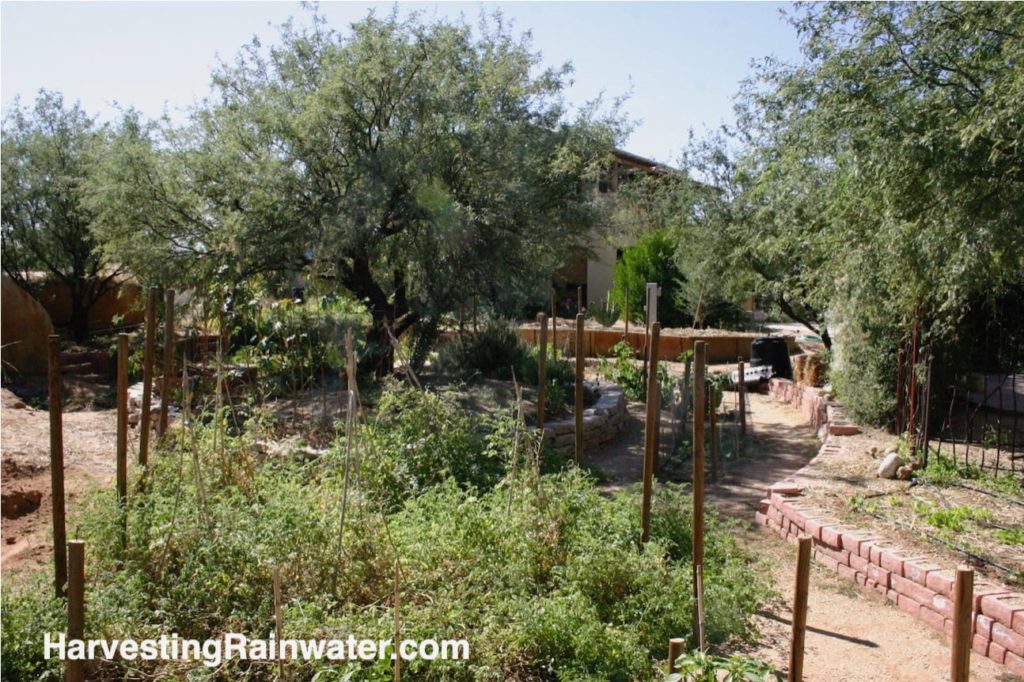
Photo: Brad Lancaster, 10-2008.
A bigger shift
To maximize the performance and potential of the water-harvesting landscape, more needed to change—the plant palette.
The original landscape plan for Stone Curves was very different from what was later implemented. The original landscape plan would’ve been far more water consumptive, costly, and maintenance heavy, as it called for mostly non-native ornamental plants, heavy water users such as sycamore trees, and over twice as much turf. Thankfully, a team of future residents who had invested in the project and resident subcommittees such as the Green Team, and Brad Lancaster (hired on as a consultant and designer) worked with the developer, landscape architect and rest of the community to dramatically shift the plant palette of the site’s landscape and that of the adjoining public rights-of-ways. The result was majorly reworked landscape plan emphasizing Tucson Basin food- and medicinal-bearing native plants that hugely reduced the water needs and maintenance of the landscape, while also providing excellent wildlife habitat and a direct connection to, and collaboration with, Tucson’s unique ethnobotanical history and ecology.
As residents moved in, many then incorporated passive water harvesting basins within their private back yards and installed rainwater-harvesting tanks that overflowed to the adjoining basins. This work was made easier with water-harvesting consultations, design, and community workshops offered to all new residents. Some of this was funded by a community challenge grant from the Arizona department of forestry and fire management. And the learning extended well beyond Stone Curves, since along with 11 residents of Stone Curvers, 70 people from around Tucson attended/volunteered at the workshops and then returned to their homes and neighborhoods with water harvesting knowledge/skills to share further.
The landscape also gets supplemental irrigation from the City’s municipal water supply via a drip irrigation system (or sprinklers for the turf), but this likely would not have been needed (except for the turf), if greywater was also harvested in the landscape. (And as to the turf, a number of residents have told me they wished the amount of water-consumptive turf had been reduced further, and that the community was discussing options to retroactively reduce the turf).
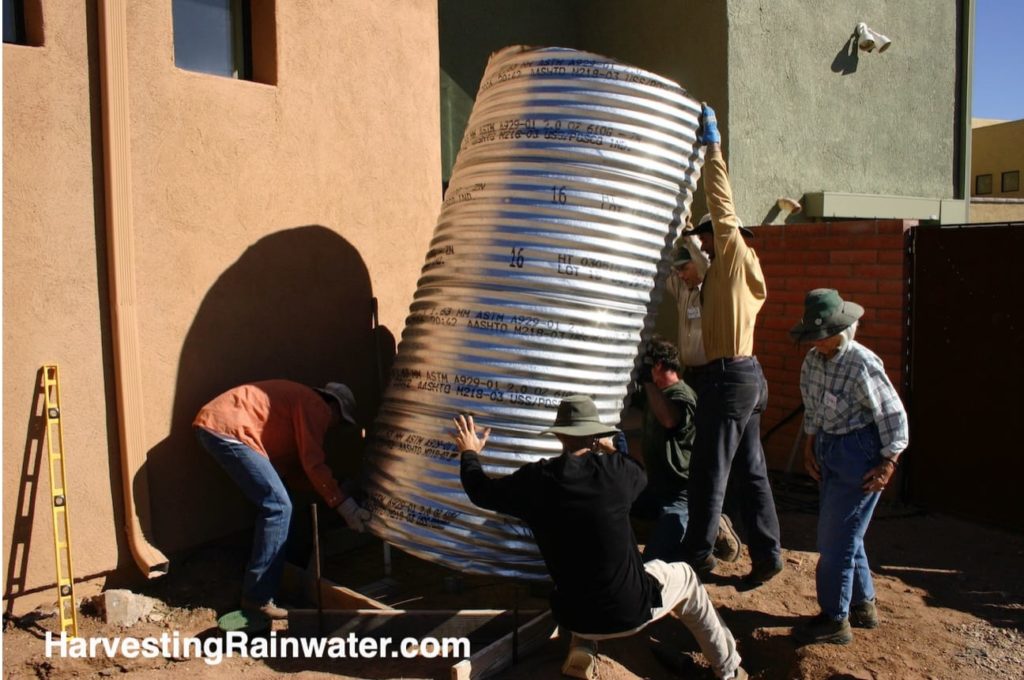
Photo: Brad Lancaster, 12-2006.
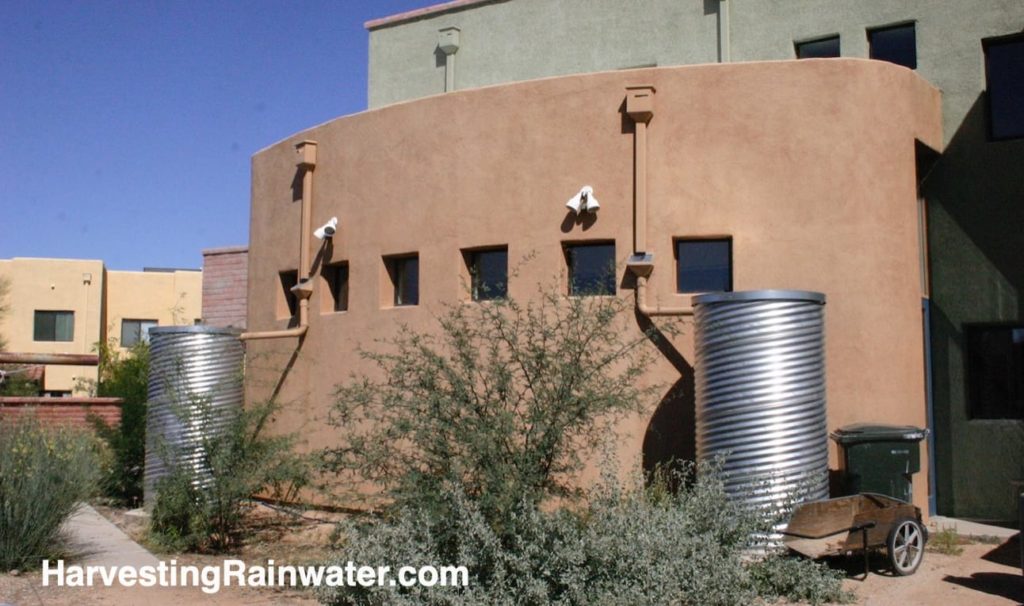
Photo: Brad Lancaster, 10-2008
Greywater harvesting
Ideally, all ground-level apartments should have been built with greywater-harvesting stub-outs, which would have allowed for easy distribution of household greywater into the landscape’s rainwater-harvesting basins. And this almost happened, as it was in the contract with the plumbing contractor. But unfortunately the contractor died unexpectedly before implementing the contract, and the greywater harvesting stub-outs did not transfer to the contract with the replacement contractor.
Simple and effective, tankless greywater harvesting had been legalized by the time this development was built, but it preceded the City of Tucson’s greywater-harvesting stub-out ordinance. Nonetheless, the community’s laundromat was retrofitted to harvest its greywater.
A greywater-harvesting laundromat
The community has a laundromat with three washing machines from which their greywater is redirected via branched-drain gravity-fed drain pipes to irrigate fruit trees in the community orchard.
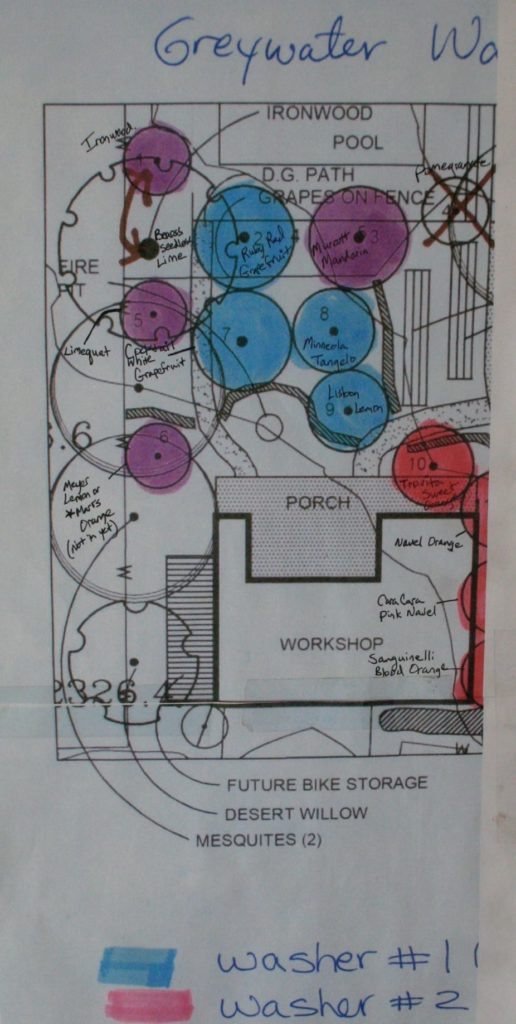
Photo: Brad Lancaster
For a more thorough description of this greywater system, and how it could be easily enhanced see the real-life examples section of the greywater harvesting chapter in Rainwater Harvesting for Drylands and Beyond, Volume 2, 2nd Edition.
And for a simple gravity-fed system harvesting washing machine greywater, which may work for your home see here.
A water-harvesting native food forest in the adjoining public rights-of-way
You do not need to schedule a tour to visit/view the perimeter landscaping within the public right-of-way on the south, east, and north sides of the development. You can view all this from the public sidewalk along Stone Ave and Limberlost Drive.
Much of the vegetation on the perimeter of the site was transplanted from the core of the site to make way for the buildings and parking lot. Water-harvesting earthworks/topography were created, then the plants were transplanted within the basins.
The City did NOT want any vegetation in this area. Instead, the City wanted the public right-of-way left devoid of any plantings so in the future they could more easily widen Stone Avenue into what is currently the well-vegetated perimeter landscape. This would have resulted in a bleak, lifeless, solar-oven-like environment.
Thankfully, James Hamilton, the Stone Curves project manager, chose to go against the City’s wishes, so now there is a diverse native food forest cooling the neighborhood, sheltering native song birds and other wildlife, and buffering traffic noise and pollution. The curving rusty-orange property line wall is only a couple of inches thick. It is made of ferro-cement—a metal skeleton plastered with cement that was then stained with ferrous sulphate. The outward curve of the top of the wall, along with the vegetation was meant to further reduce traffic noise entering the development—beneficial redundancy.
Spreading good works by talking with, and getting to know, your neighbors
When the development on the western boundary of Stone Curves was being built, two of Stone Curves active and diplomatic residents, Garth and Suzanne Mackzum reached out to the developer and offered to show him what had been done at Stone Curves as he might get some ideas he’d like to incorporate into his development.
The developer met with Garth and Suzanne and they spoke a number of times, developing a rapport. And while the developer did not incorporate water harvesting into the neighboring development’s plan, he did change the landscape tree pallet to be predominantly Tucson native trees. This was huge because the original tree plan called for higher-water-use, higher-maintenance, drought-susceptible non-native trees that would have offered close to no native wildlife value. By switching to native trees the development reduced its water needs and landscape maintenance costs, while expanding the high-quality native wildlife habitat (and native foods) being grown at Stone Curves. A big win for all.
For more information: StoneCurves.org
Where:
4133 N Stone Ave, Tucson, AZ
8570532.28085284687516, -110.97271370376036
Please respect the privacy of this community, and do NOT visit in person, unless you have arranged a tour with the Stone Curves community – see below.
To schedule a tour:
Contact Stone Curves
Though the native food forest in the public right-of-way on the east and north sides of the community can be viewed anytime from the public sidewalks along Stone Avenue and East Limberlost Drive
This location is included in the following tours:
See the new, full-color, revised editions of Brad’s award-winning books
– available a deep discount, direct from Brad:

Volume 1

